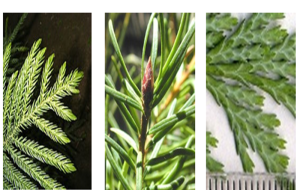68 Conifers
Conifers are a highly successful group of plants. They have modified leaves, either in the form of scales or needles, as shown in the figures. Most conifers are evergreen, so they do not shed all their leaves at one time. Conifers are particularly common in cold and/or dry regions, where being evergreen and having smaller leaves makes good use of short growing seasons while reducing water loss.
The word “conifer” comes from the reproductive structures, which are commonly called cones. Conifers have separate male and female cones on the same plant. Male cones mature more quickly than female cones, reducing the chance of self-fertilisation. Wind moves pollen to female cones.


Conifers and their distribution
Worldwide there are around 470 species of conifers; Australia is home to around 43 native species. There is only one native conifer commonly found in the Top End of the Northern Territory, Callitris intratropica (not to be confused with Calytrix, a genus in MYRTACEAE or Callithrix, a genus of New World monkeys).
In the south, Callitris columellaris and C. glaucophylla can be found.
They are part of the CUPRESSACEAE family, so leaves are reduced to tiny scales that lie flat along the branches (like photo c above).
There is also a small patch of Podocarpus grayae (Brown Pine) found in western Arnhemland. These have flattened awl-type leaves.
